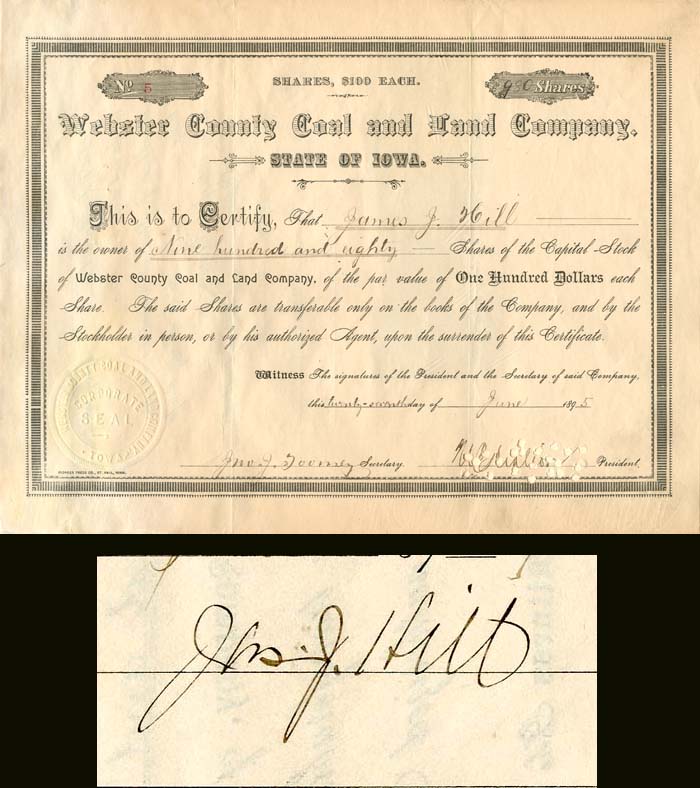Webster County Coal and Land Co. signed by James J Hill
Inv# AG1690 Stock
State(s):
Iowa
Years:
1895
Stock issued to and signed at back by James J. Hill. Extremely Rare! Portrait and biographies included.
James Jerome Hill (September 16, 1838 – May 29, 1916), was a Canadian-American railroad executive. He was the chief executive officer of a family of lines headed by the Great Northern Railway, which served a substantial area of the Upper Midwest, the northern Great Plains, and Pacific Northwest. Because of the size of this region and the economic dominance exerted by the Hill lines, Hill became known during his lifetime as "The Empire Builder”. During the Panic of 1873, a number of railroads, including the St. Paul and Pacific Railroad (StP&P), had gone bankrupt. The StP&P in particular was caught in an almost hopeless legal muddle. For James Hill it was a golden opportunity. For three years, Hill researched the StP&P and finally concluded that it would be possible to make a good deal of money off the StP&P, provided that the initial capital could be found. Hill teamed up with Norman Kittson (the man he had merged steamboat businesses with), Donald Smith, George Stephen and John Stewart Kennedy. Together they not only bought the railroad, they also vastly expanded it by bargaining for trackage rights with the Northern Pacific Railway. In May 1879, the St. Paul, Minneapolis, and Manitoba Railway Co. (StPM&M) formed—with James J. Hill as general manager. His first goal was to expand and upgrade even more. Hill was a hands-on, detail-obsessed manager. A Canadian himself of Scotch-Irish Protestant ancestry, he brought in many men with the same background into high management. He wanted people to settle along his rail lines, so he sold homesteads to immigrants while transporting them to their new homes using his rail lines. When he was looking for the best path for one of his tracks to take, he went on horseback and scouted it personally. Under his management, StPM&M prospered. In 1880, its net worth was $728,000 (equal to $19,286,979 today); in 1885 it was $25,000,000, equal to $711,388,889 today. One of his challenges at this point was the avoidance of federal action against railroads. If the federal government believed that the railroads were making too much profit, they might see this as an opportunity to force lowering of the railway tariff rates. Hill avoided this by investing a large portion of the railroad's profit back into the railroad itself—and charged those investments to operating expense. It was at this point that Hill went from general manager to the official president of StPM&M, and thereafter decided to expand the rail lines. Between 1883 and 1889, Hill built his railroads across Minnesota, into Wisconsin, and across North Dakota to Montana. When there was not enough industry in the areas Hill was building, Hill brought the industry in, often by buying out a company and placing plants along his railroad lines. By 1889, Hill decided that his future lay in expanding into a transcontinental railroad. "What we want," Hill is quoted as saying, "is the best possible line, shortest distance, lowest grades, and least curvature we can build. We do not care enough for Rocky Mountains scenery to spend a large sum of money developing it." Hill got what he wanted, and in January 1893 his Great Northern Railway, running from St. Paul, Minnesota to Seattle, Washington — a distance of more than 1,700 miles (2,700 km) — was completed. The Great Northern was the first transcontinental built without public money and just a few land grants, and was one of the few transcontinental railroads not to go bankrupt. Hill chose to build his railroad north of the competing Northern Pacific line, which had reached the Pacific Northwest over much more difficult terrain with more bridges, steeper grades, and tunnelling. Hill did much of the route planning himself, travelling over proposed routes on horseback. The key to the Great Northern line was Hill's use of the previously unmapped Marias Pass. The pass had initially been described by Lewis and Clark in 1805, but no one since had been able to find it so Hill hired Santiago Jameson to search it out. Jameson discovered the pass 1889 and it shortened the Great Northern's route by almost one hundred miles. The pass had been discovered by John Frank Stevens, principal engineer of the Great Northern Railway, in December 1889, and offered an easier route across the Rockies than that taken by the Northern Pacific. The Great Northern reached Seattle in 1893. In 1898 Hill purchased control of large parts of the Mesabi Range iron mining district in Minnesota, along with its rail lines. The Great Northern began large-scale shipment of ore to the steel mills of the Midwest.Condition:
Excellent
A stock certificate is issued by businesses, usually companies. A stock is part of the permanent finance of a business. Normally, they are never repaid, and the investor can recover his/her money only by selling to another investor. Most stocks, or also called shares, earn dividends, at the business's discretion, depending on how well it has traded. A stockholder or shareholder is a part-owner of the business that issued the stock certificates.
Item ordered may not be exact piece shown. All original and authentic.









Ebay ID: labarre_galleries